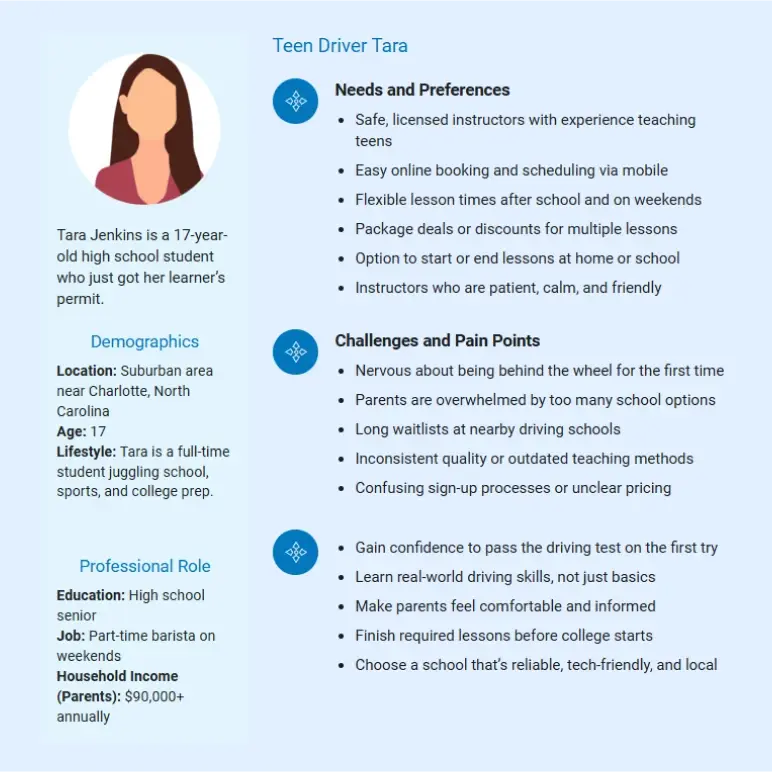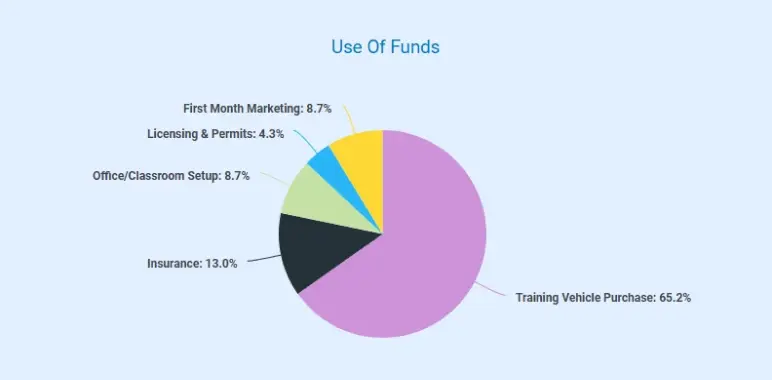Starting a driving school sounds exciting. You’re probably dreaming of full classes, smooth road tests, and maybe even a five-star Google rating.
But before you hit the road, you need a solid business plan that helps you manage daily operations, attract students, stay compliant with local laws, and keep your finances on track.
Wondering how to draft a plan?
Not to worry! This free driving school business plan template will walk you through every step and help you build a plan that sets you up for success.
What is a driving school business plan?
A business plan for a driving school is a detailed written document that outlines how your driving school will operate and develop.
The driving school business plan helps you outline your objectives, the services you will offer, your target market (children/adults/ or both), competitors, sales strategy, and how much you expect to earn and spend.
In short, it’s a daily guide for how you’ll manage your driving school, including how you’ll conduct training sessions and operate profitably.
Why is a driving school business plan important?
Creating a business plan might feel like an extra step, but it’s a crucial one. Here are a few clear reasons why a business plan is important for your driving school:
- Helps you set clear goals: A business plan helps you to create a short- and long-term plan and helps you know what you are working towards.
- Supports legal compliance: It helps you keep up to date with all your licenses for instructor training, required permits, insurance for your vehicle, and vehicle safety.
- Increases your chances of funding: Banks and investors want to see that you have planned your venture through. It demonstrates you are serious and have prepared.
- Avoid costly mistakes: Writing the plan helps you identify any missing information or weaknesses before they become major problems.
- Simplify decisions: A solid business plan will assist you with daily decisions related to price, class schedules, and operating your driving school.
- Builds confidence: Shows clients, partners, and even yourself that you’re committed and ready to succeed.
In summary, a business plan can help keep your driving school moving in the right direction.
A good business plan shows that you have done research, have made plans for the future, and establishes a basis for growth with minimal waste of time and financial resources.
How to create a business plan for a driving school?
Writing a business plan might sound intimidating, but it can be broken down into a series of manageable steps. Here’s a step-by-step process to create a solid business plan for your driving school:
1. Executive Summary
The executive summary is the opening section of your business plan, but it’s typically written last. It provides a quick overview of your driving school business plan, highlighting the most important points.
Think of it as the “elevator pitch” for your plan – if a reader only reads the executive summary, they should still grasp the essence of your business and its viability.
Here’s what to include in your executive summary:
- Company overview: Who are you, and what kind of driving instructions do you provide?
- Target market: Who are your main customers? Are you focusing on teens getting their first license, adults needing refresher lessons, or senior drivers?
- Unique Selling Proposition: What does your driving school stand for? These can be experienced instructors, high-to-average pass rates, and advanced driving simulators.
- Professional objectives: Include some simple goals, such as “Train 200 students in year one” or “partner with three local high schools within six months.”
- Major financial estimate: Give a high-level snapshot of your expected revenue projections and profit margins for the first year or two.
- Funding request (if applicable): If you’re looking for funding, say how much you’ll need and what it’s for, such as vehicle, insurance, class setup, or marketing.
Overall, your executive summary should clearly answer who, what, and why your business is.
Place it under two pages and focus on making it inspiring. If anyone only reads this section, they should understand the origin of your driving school and why it’s worth investing in or supporting.
Say goodbye to boring templates
Build your business plan faster and easier with AI
Plans starting from $14/month

2. Business Description
Now it’s time to describe your driving school in more detail!
The company overview provides a clear snapshot of who you are, what you do, and where you’re headed. It’s your chance to set the tone for everything that follows in the business plan.
Here are the key elements to include:
- Company name and location
- Legal structure
- History and milestones achieved (if any)
- Mission and vision
- Business values
- Future goals
This section should leave the reader with a strong sense of your driving school’s identity, what makes it valuable, and what you’re aiming to accomplish.
3. Industry and Market Analysis
The industry and market analysis section demonstrates your understanding of the environment in which your driving school will operate. Here, you will analyze the driving school industry at large as well as the specific market in your geographic area and niche.
While planning this section, consider including these key elements:
Industry Overview
Describe the current state of the driving school industry. Mention trends affecting the market, such as steady demand for driver’s education, increased use of simulators and online classes, or regulatory changes that impact instruction requirements.
Target Customers
Identify your ideal clients and their needs. These may include teenagers, adults who have never learned to drive, or companies that require driver training.
Highlight their main concerns, such as safety, convenience, or pass rates, and explain how your school will meet those needs.

Regulatory Environment
Briefly mention the legal considerations in your area, including required licenses, certifications for instructors, and vehicle insurance. This shows that you understand state requirements and are prepared to operate legally and responsibly.
By conducting a detailed market analysis, you’ll show potential investors, clients, and partners that you understand the driver education industry, local demand, and how your school fits into the market.
4. Competitive Research
The driving school industry is competitive, especially in areas with multiple training providers.
To stand out, you need to do some basic competitor research. This shows that you understand your local market and know how your school will offer something better.
In this section, you have to list out your top competitors, analyze what they do well (and not so well), and explain how your school will do it differently.
Here’s how to write this part effectively:
Step 1: List the major driving schools near you. Include both local instructors and bigger schools with multiple instructors or locations.
Step 2: Note down their course offerings, pricing, years in business, and reputation. Check out their websites, reviews, and social media pages to gather this info.
Step 3: Compare their services with what you plan to offer. Do they use new cars? Do they offer online booking? Weekend lessons? What are their standout features—and what are they missing?
Step 4: Write down how your driving school will stand out. Maybe your school has flexible scheduling, bilingual instructors, or a better pass rate on driving tests.
Step 5: Look for service gaps. If no one offers lessons in the evenings or free pickup, and you do, highlight that clearly.
Use this info to build a short strategy for how you’ll compete. Think about pricing, service quality, partnerships, or promotions.
Doing this research helps shape your marketing approach and shows investors that you know your competitors and have a real plan to win students over.
5. Services Offered
This section of your driving school business plan explains what you’re offering, how students access these services, and how they’re priced.
Start with your core offerings. Most schools provide a standard driver’s education program (classroom or online theory plus behind-the-wheel training), individual driving lessons, defensive driving courses, and road test prep.
Next, list features that add value.
- Do you offer home pickup for lessons?
- Are mock tests included?
- Do you teach both automatic and manual?
Mentioning things like senior refresher courses or specialty training for CDL (Commercial Driver’s License) can help you stand out.
Then, explain your pricing strategy. Are services sold hourly, in lesson packages, or full-course bundles? Do you offer tiered options or payment plans? Pricing should align with market rates and your value.
Don’t forget other revenue streams like car rentals for DMV (Department of Motor Vehicles) tests or referral fees from online theory partners.
Finally, if you plan to expand—adding new courses or becoming a third-party test site—mention it briefly. It shows potential for growth and adaptability.
6. Marketing and Sales Strategy
Having skilled instructors and solid courses is great, but none of it matters if no one hears about your school. This section explains how you’ll attract students, turn inquiries into enrollments, and keep the business growing.
Marketing strategy
Your main goal is lead generation. You need people to know your school exists, trust it, and feel confident reaching out. Use a mix of digital and local outreach, like:
- Build a website that clearly lists your services, pricing, and sign-up options
- Use Facebook and Instagram to share success stories, driving tips, and reviews
- Run Google Ads targeting search terms like “driving school near me.”
- Reach out to local high schools for flyer distribution or student discounts
- Offer referral rewards (like a free lesson for each friend referred)
- Add signage to your training vehicles so your brand is visible on the road
Sales strategy
Once you get leads, your sales strategy turns them into paying students. Respond quickly to inquiries, offer clear course options, and make sign-up easy, whether online or over the phone. Consider:
- Offering a free consultation call or a sit-in session
- Using a simple booking system for lessons and payments
- Following up with leads via email or text reminders
- Requesting online reviews after course completion to boost future credibility
This shows you’re not just waiting for students to find you—you’re actively reaching out and making it easy for them to choose your driving school.
7. Operations Plan
The operations plan explains how your driving school will function day to day. While earlier sections talk about what services you’ll offer, this section shows how you’ll actually run things behind the scenes.
Here’s what to include in your operations plan:
- Where will you operate from? Will you run classes in a physical location or offer online sessions?
- What vehicles and tools do you need? List your training cars and any other equipment, like simulators or classroom materials. If you’ll use scheduling software, note it here.
- Who will run operations? Will you handle it alone or hire staff? Include plans for instructors, office help, or part-time support. Make sure to note that all instructors are certified and insured.
- How will you deliver your services? Briefly describe the student process—from enrollment and class scheduling to behind-the-wheel training and final assessments.
- How will you handle communication? Outline how students will contact you and how you’ll manage updates or reminders.
- How will you maintain safety and quality? Cover things like car maintenance, instructor training, record-keeping, and state compliance.
This section should show you’ve thought through the details and can run the school reliably, safely, and efficiently. Solid operations lead to better student outcomes and a smoother business overall.
8. Management Team
Investors and stakeholders bet on individuals as much as on ideas. The management team section highlights who’s running the driving school and why they’re qualified to make it work.
If you’re the founder, start by introducing yourself and your background. Mentioning your qualifications shows you have both the credentials and experience to run the business.
If you have co-founders or key team members, introduce them briefly. Include each person’s names, job roles, responsibilities, skills, and relevant industry experience.
You can also include an organizational chart to explain how roles are structured and how decisions are made. For instance:

If applicable, mention mentors or advisors. If you’re working with a former DMV examiner, driving instructor trainer, or small business coach, list them here to show additional support.
Overall, this section should give confidence that your driving school has the right people in place to run and grow the business.
9. Financial Projections
The financial plan is where you translate all your business ideas into numbers. This section shows that your driving school is financially viable and is a significant focus for investors or lenders.
Your financial plan should include predicted details for the next 3-5 years. Here are the major components to cover:
- Revenue estimates: Income from alternative services such as course packages, individual texts, and defensive driving workshops.
- Operational expenditure: Project costs such as instructor salary, fuel, vehicle maintenance, insurance, rent, software membership, marketing, and general administrator expenditure.
- One-time startup cost: Include initial purchase of vehicle, double control modifications, signage, office or class setup, license, and first month marketing.
- Profit and loss: Estimate your yearly profit or loss based on expected income and expenses. Show when the business is likely to become profitable and include key figures.
- Cash flow forecasts: Plan how money comes in from course fees (often paid upfront) and goes out for things like salaries, fuel, and vehicle upkeep.
- Balance sheet: Provide a summary of your assets, liabilities, and equity to reflect the overall financial health of your school.
If you’re seeking funding, state how much you need and what it’s for. Briefly explain how the money will be used and how you plan to repay it. You can add a simple use of funds chart as shown below.

This will give potential investors or lenders more clarity about your fund allocations.
And yes, don’t forget to state your financial assumptions—like average student volume, pricing, and cost increases—and make sure they match your projections and strategies.
Download a free driving school business plan template
Ready to start crafting your own driving school business plan from scratch? But need more assistance with that? Don’t worry! Download our free driving school business plan template PDF to get started.
This professionally designed template is specifically for driving schools, including behind-the-wheel training, classroom instruction, and online driving courses. Use it as a reference while writing your plan, and feel free to customize it to suit your services, style, and business objectives.
The Quickest Way to turn a Business Idea into a Business Plan
Fill-in-the-blanks and automatic financials make it easy.
Conclusion
Now that you’ve gone through the guide and grabbed the free template, writing your driving school business plan should feel more manageable.
However, if you’re still feeling stuck or want a faster way to create a polished plan, Upmetrics can help. It’s an AI-powered business plan generator that makes planning easier and faster.
It also offers financial forecasting, market insights, and everything you need to build a plan that appeals to investors.
Start your driving school plan today with Upmetrics.



